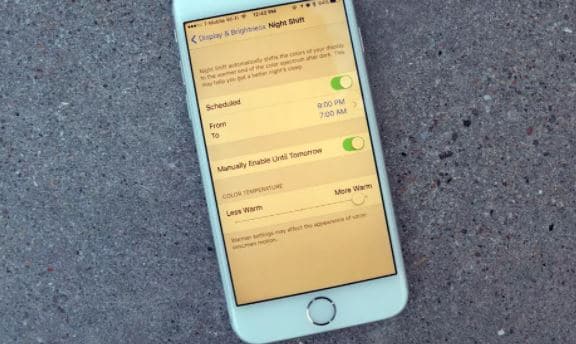You can find blue light everywhere. Blue light flows through the earth’s environment and interacts with the light sensors in your eyes and skin. People are frequently exposed to this blue light in artificial and natural settings such as LED devices such as tablets, laptops, and phones. There is not a lot of evidence about the long-term risk to our health due to these high blue light levels. However, experts are still working on that.
Contents
- 1 Can Blue Light Cause Headaches?
- 2 Is It True That Blue Light Can Trigger Migraine Attacks?
- 3 Other Side Effects Of Blue Light
- 4 Damage To Skin
- 5 Sleep Disruption
- 6 Signs You May Have a Blue-light-induced Headache
- 7 How To Prevent And Avoid Getting A Headache From Blue Light
- 8 Adjust The Workstation To Help Get a Proper Posture
- 9 Change The Light Settings On The Device
- 10 Take Breaks To Stretch
- 11 Keep Your Eyes Moist
- 12 Try The 20/20/20 Method
Can Blue Light Cause Headaches?

As you must know, digital eye strain implies many symptoms linked to using digital tools for too long. Symptoms could be:
- sensitivity to light
- headache
- neck pain
- dry eyes
- blurry vision
- tired or sore eyes
- shoulder pain
Tablets, computer screens, cell phones, and laptops can be the reason for digital eye strain. However, each of these devices releases blue light. The link has led researchers to examine if it is only the blue light that is the reason for digital eye tension. Until yet, there is not sufficient research to determine that the light color points to DES symptoms. However, experts think the real reason is a whole day of demanding work, instead of only the blue light emanating from those screens.
Is It True That Blue Light Can Trigger Migraine Attacks?

Extreme light sensitivity hits about 80 percent having migraine attacks. This light sensitivity is so strong that people only get comfort by being in a dark place. Researchers found that amber, blue, red, and white light can worsen their migraines. It can also increase muscle tension and throbbing. In a study with 69 people having sharp migraine headaches, green light did not aggravate their headache. For many people, green light improved the symptoms.
A study has seen blue light-triggered neurons rather than different colors, leading the researchers to refer to blue light as the most photophobic light. Therefore, the more severe the white, blue, amber, and red light, the more severe the headache. It’s essential to know that as blue light makes the migraine worse, it is not the same as the only reason for the migraine.
Research has shown that it is not the light that can trigger a migraine. Rather, this is the brain’s way of processing light. People prone to migraines can have light receptors and nerve pathways in the eyes, especially sensitive to light. Most of the researchers have recommended blocking every wavelength of light other than the green light throughout the migraine, and many had reported that the light sensitivity was gone when they used anti-blue-light eyeglasses.
Other Side Effects Of Blue Light
Damage To Skin

Exposure to UVB and UVA rays can damage the skin and increase the chances of skin cancer. There is evidence that blue light exposure can also damage the skin. A study from 2015 has shown that blue light exposure increased the number of free radicals on the skin and decreased antioxidants.
Sleep Disruption

A study conducted in 2018 showed that headaches and sleep disturbance go parallel. Sleep problems will lead to migraine headaches and tension, resulting in you losing your sleep.
Signs You May Have a Blue-light-induced Headache

If you have been using a blue light-emitting device, you will notice these symptoms:
- Headache
- Squinting
- Tension in the shoulder, facial, and neck muscles
- Blurry vision
- Increased sensitivity to light
- Burning, stinging, sore, or itchy eyes
How To Prevent And Avoid Getting A Headache From Blue Light
Adjust The Workstation To Help Get a Proper Posture

If you spend a very long time on your computer without considering your sitting posture, you might be more prone to get headaches.
- Place the monitor at eye level to avoid bending your neck a lot.
- Use a lumbar support pillow to support your lower back or adjust your chair
- Put the keyboard one or two inches above the thighs.
- Lower or raise the armrests so that the shoulders can relax while working.
- Use a screen to decrease the brightness of the devices.
- Keep the monitor twenty to twenty-five inches from the body.
Change The Light Settings On The Device

Many devices include the feature to change from blue light to a warm tone. Some switching to night mode or warm tones on a device will help maintain the body’s ability to produce melatonin.
Take Breaks To Stretch

Muscle tension can cause headaches. To ease some of the tension, you should do stretches to relax the muscles in your upper back, neck, head, and arms.
Keep Your Eyes Moist

When you concentrate on a difficult task or stare at a screen, you probably blink much less than you usually should. Using artificial tears, office humidifiers, or eye drops can help you keep moisture levels in the eyes to a proper level if you are not blinking sufficiently.
Try The 20/20/20 Method

Pause after 20 minutes, concentrate on anything about 20 feet away, and look at it for 20 seconds. This variation in the distance will give your eyes a rest from intense and up-close focusing.
CONCLUSION
Playing or working for long hours on blue light-emitting devices such as tablets, phones, and laptops, will lead to headaches—but it might not be the light that creates problems. It might be light sensitivity, posture, eye strain, or muscle tension. Researchers do not exactly know how blue light can affect your eyes or overall health. Therefore, it is good to get routine eye check-ups and consult your doctor if headaches interfere with life quality.


